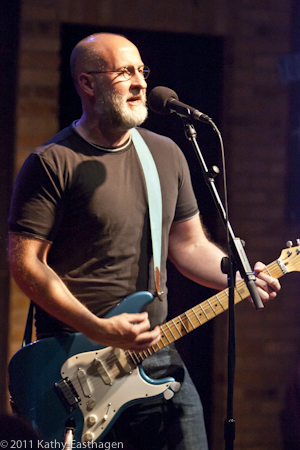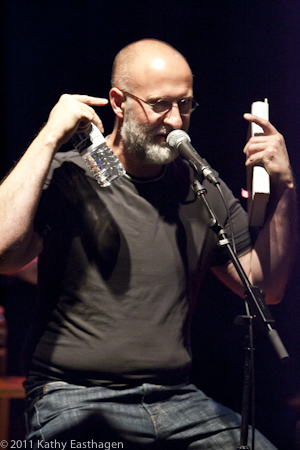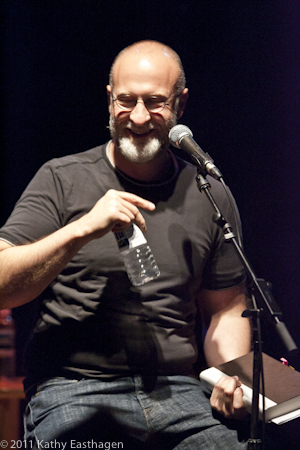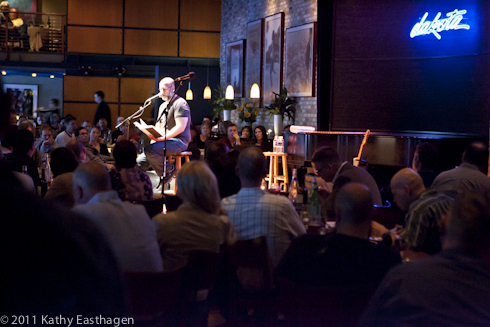
Is Bob Mould his own best critic? Maybe it’s just the analytical and relatively impartial mind of co-author Michael Azerrad speaking through the more intimate reflections in Mould’s new autobiography See A Little Light, but either way the evening of reading and music at the Dakota Jazz Club in support of the book’s release included some damn good criticism. The previous night Mould had read very personal excerpts at Minneapolis bookstore Magers & Quinn, largely detailing his progress toward becoming a “fully integrated gay man,” but the selected readings at the Dakota—a sort of curated life of Mould, rendered in five representative albums—balanced this autobiographical context with a broader critical context, Mould playing outside observer to his own past’s body of work.

Some among the post-author set may argue that the biographical is irrelevant anyway, though for those of us who have thoroughly internalized Mould’s songbook (or, for the academically minded, externalized it as theory), what’s left to do but confront the force that pushed it there? But beyond this, See A Little Light promises to be a useful listener’s guide, measuring a life in albums and defining those by the places that inspired them: an isolated Minnesota farmhouse full of empty rooms fit only for solitary rumination (Workbook); a car equipped with simply a guitar and a jug of water for long highway drives, and a loft in loud, sleepless Tribeca (Sugar’s Copper Blue); a spacious Austin, Texas home in which two lovers lived at opposite ends (the eponymous “Hubcap” album); a Washington D.C. house nearly used up as a recording space, but with boxes of old stuff lurking in the corners, waiting to be rediscovered (Life and Times); a Minneapolis basement apartment, a repurposed church, and a van (Hüsker Dü’s Zen Arcade).
Mould’s description of the latter album’s genesis, during a backtracking, origin story encore, led to a sort of heartbreaking admission that Zen Arcade means more to others than it does to him, that he had outgrown the feelings it documents by the time they’d been written down and recorded. I think a lot of the album’s admirers probably feel that way, that it’s the ultimate document of an adolescent chaos that can never be felt so intensely again, but still an undeniable work of art.
More significant to Mould is 2009’s Life and Times, “the best record I’ve made in a long time,” as he put it (I’d say it’s the best of his solo work, a harbinger of his book and a synthesis of everything that came before, both musically and lyrically). Even a skeptic would have to admit he spoke convincingly of the album’s accomplishments: its dust to dust structure, stirred up from one of those boxes of old stuff—coated in the ash of New York City, 2001—during the opening title track and settling back down by the time the album draws to a close; the lovers’ quarrel of “The Breach,” with its two voices nearly overlapping in argument and then coalescing; the eager, subordinated verses of solid attempt at AM gold “I’m Sorry, Baby,” tilting toward and anticipating the chorus.

All these songs were given Mould’s now-customary solo electric treatment, a mode of performance that requires considerable courage, given that all nuance can easily get washed away in the supercharged sea (the quiet articulation of acoustic must seem easy by comparison). But unaccompanied electric guitar seems to suit Mould perfectly these days; his voice rarely stops cutting through the chords, filling in every contour with shouts and hollers and melodic variations. He spoke about cutting his teeth as a performer at First Avenue and other Minneapolis venues in the 1980s, and it’s staggering to think of the number of shows it must take to reach his level of comfort with his voice, his guitar, and his audience.
Which is to say that Mould seems to have reached that good place in life from which autobiographies get written. The Dakota proved an appropriate setting for all of this, though I wonder if Mould considers his autobiography potentially more useful for people his own age who have started sorting through the rubble of their lives than for poor confused street kids who might feel acknowledged and emboldened by his story. Those Dakota tickets aren’t cheap, so the latter group was left out in the heat to figure things out for themselves. Mould’s book will provide some little light, or more, when they find it.


